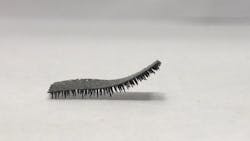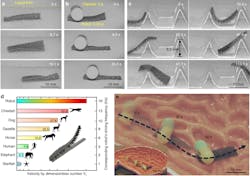Tiny Soft Robots Make Drug Delivery Efficient
Efficient drug delivery is a difficult task in the medical industry. Pills and intravenous treatments have been the main method of drug delivery for decades. Researchers have investigated other methods, like mobile pump devices that provide treatment to the patient over long periods of time, slowly, and outside of the hospital environment.
Another new development could potentially help solve this problem: the creation of a soft robot from the City University of Hong Kong (CityU). This mini-delivery robot has soft caterpillar legs that can carry heavy loads and is adaptable to adverse environments. It would be able to traverse inside the human body on its own to help deliver time-scheduled medication.
Biological Design Features
The inspiration for the robot’s design came from studying animals that had two, four, eight, or more legs. In particular, the engineers at CityU studied the ratio between leg-length and the gap between legs. Dr. Shen Yajing, an assistant professor at CityU’s Department of Biomedical Engineering (BME) who led the research, explains that “most animals have a leg-length to the leg-gap ratio of 2:1 to 1:1. So we decided to create our robot using 1:1 proportion.”
The robot measures 0.15 mm thick and each conical leg measures 0.65 mm long. The gap between the legs is 0.6 mm. This makes the leg-length-to-gap ratio around 1:1. The robot’s legs are specifically pointed to reduce the contact area and friction with the surface it interacts with. The laboratory test out of CityU concluded that the soft multi-legged robot had 40 times less friction than other limbless robots in either wet or dry environments.
The robot is fabricated from a silicon material called polydimethylsiloxane (PDMS). The material is embedded with magnetic particles so that it can be remotely controlled via an electromagnetic force. “Both the materials and the multi-leg design greatly improve the robot’s hydrophobic property,” says Wang Zuankai, a professor at CityU’s Department of Mechanical Engineering (MNE) who conceived this research idea and initiated the collaboration among the researchers. “Besides, the rubber piece is soft and can be cut easily to form robots of various shapes and sizes for different applications.”
Shown is a demonstration of robot locomotion in the harsh environment. a.) The robot can move with an average speed of 0.5 mm/s on wet surfaces under a drive frequency of 1 Hz, owing to its small contact area to the underlying substrate and hydrophobic tapered feet; b.) The robot’s locomotion with a loading 100 times of its own weight can move 8 mm in 45 sec; c.) Crossing a steep obstacle with height ∼10 times higher of its own leg, the robot’s posture can be easily adjusted to climb obstacles as a result of the discontinuous flap-wave mode and continuous inverted-pendulum motion locomotion mode; d.) Comparison of the normalized speed between the soft robot and other animals: The soft robot can easily reach the maximum speed of human and cheetah at a swing frequency 3 Hz and 13 Hz, respectively; e.) Demonstration of drug transport in a stomach model in a wet environment: The robot can move 32 mm in 50 sec in a harsh in vivo simulated environment, all the while carrying a medical tablet (~91.4 mg) twice as heavy as itself. (Image credit: City University of Hong Kong)
Moving Inside the Human Body
When it came time to manipulate the body, the team used a magnetic manipulator in the experiments, which cause the robot to move in a flapping and inverted pendulum pattern. The robot would use its front feet to flap forward as well as swing its body by standing on the left and right feel alternate to advance forward. The robot is extremely flexible, able to angle its body to 90 degrees when it encounters an obstacle ten times higher than its own leg length. The laboratory tests also showed that the robot could carry a load 100 times its own weight. This is strength comparable to an ant.
The soft and multi-legged robot developed from research led by the City University of Hong Kong has a remarkable loading ability of up to 100 times its weight. The video demonstrates its drug transport capability on the wet surface of a stomach model, simulating the in-vivo harsh environment. (Video Credit: City University of Hong Kong)
The robot’s freedom of movement and strength are the attributes that would make it a perfect drug delivery system. The soft robot would be able to traverse a terrain like the digestive system, an environment that is harsh and difficult to navigate, and deliver a drug to a designated spot in the human body. The robot could also be used for medical inspection.
The team from CityU are looking forward to experimenting with the robot on animals and humans to help further develop and refine the robot’s movements and technique. “We are hoping to create a biodegradable robot in the next two to three years, so it will decompose naturally after its meds delivery mission,” says Yajing.


